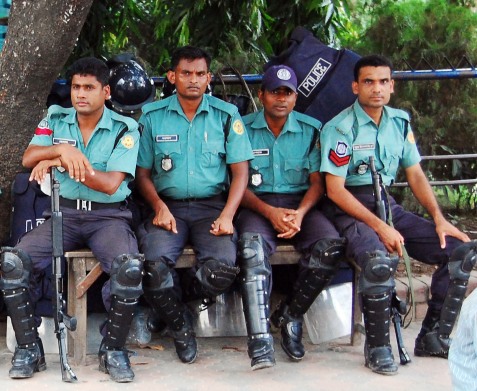The obvious and historic face of Bandarban is of course an Indigenous one, for me there is no argument over this. In reality however a much more varied and wider reaching population can currently be found represented here. Over the remaining months that I spend living in this busy little town, where I too form part of that rich variation, I will attempt to capture and record some of those faces in the form of establishing a photographic portrait gallery, adding to this post as time passes.
“A small group of Muslim school boys I met one morning in Bandarban town, who found both me and my camera a little more interesting than arriving at their class in the local Mosque on time!”

“It’s pretty typical for a field trip to take place during the working day. At this time the people you are most likely to meet comprises of the very young, along with the older residents, who are not out Jhum cultivating in the jungle, which provides income for the vast majority of village inhabitants. At this Marma village I ‘chatted’ with this old lady who was almost deaf and losing her sight. At 88 years old however I was stunned at how mobile she still was, as I watched her climb the dozen or so steps of the wooden ladder up to her home.”

“While on a recent field trip to a village just outside Bandarban town itself, I met, as is usual, some of the young children living there. While always shy at first, soon a combination of curiosity and the universal mischief of all young boys kicks in. First they start giggling and then daring each other to speak to me. When I offered to take their photograph however they suddenly took it all very seriously!”

“This photograph represents three generations. Unusually the older woman pictured here is not wearing the traditional Marma tribal dress, as can be seen worn by her daughter, who is standing in the doorway behind her.”

“This woman belongs to the Mru or Mro tribe and is the wife of the Headman of the village I have visited on a couple of occasions. She has become a friend who stays close to my side the entire time I spend here. When we first met she was fascinated with my camera and was so once more when we met again recently. After taking this photograph, she was very curious and satisfied to see her own image ‘inside’ it at last.”

“This little girl and her younger brother also belong to the Mro tribe but live in a different newly built village, not far from Bandarban town. ”

“As can often be seen on the streets of Dhaka city, here in Bandarban women also work alongside the men on building sites, often continuing right through the heat of the mid-day sun.”

“This mother, wearing traditional dress, and her baby boy belong to the Chakma people, who are the largest ethnic group in the Chittagong Hill Tracts, making up more than half the tribal population. The Chakma historically ruled the Chittagong Hill Tracts under the control of a King, whose lineage is still recognised today.”

“This man, hammer in hand, stopped breifly from his work, breaking down bricks into small chips, which are required as building material. His entire family labour here beside him, right down to his five year old daughter”.

“I met these two Tripura women as they stepped of a small wooden boat on the banks of the Sangu river. Each removed one of their many bead necklaces and offered them to me. I wasn’t only taken aback, but found it quite emotional. I couldn’t let them leave without taking their photograph to remember them by.”

“I met this amazing man fishing with a small hand net in the large pond close to my flat. To my delight he was remarkably successful. He looked very serious in my first few photographs, and when I encouraged him to relax and smile he proved remarkably successful doing that also!” 
“This lovely little Mro village girl I met recently, dressed so smartly in her school uniform, needed no encouragement to smile. In fact I found it so infectious I couldn’t stop smiling myself!”

“I met this gentleman down on the banks of the Sangu river as it runs through Bandarban town. I love to go there on my day off to take in the sights and he came over for a brief ‘chat’, which we did through my terrible Anglo-Bengali lingo!”

“Lunchtime today, just outside my office, I realised watermelon is back in season!”









































